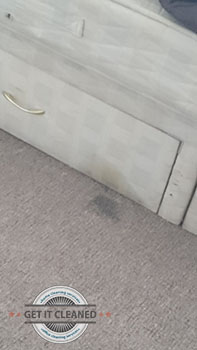Dry carpet cleaning is the one of the now popular cleaning methods to have entered the scene at a later stage, since development of these dry cleaning chemicals and techniques happened not that long ago. The method is called dry cleaning because basically it uses no water whatsoever to clean the carpet.
 When cleaning carpets in this way, they are sprinkled with a special dry cleaning compound, which contains tiny particles of water, solvent and detergent. Optionally, the dry cleaning compound can be worked into the carpet using a machine. The cleaning compound agitates dirt and grime in carpet fibres, the use of the machine drives and spreads the compound evenly, deeper inside the carpet thus yielding better results.
When cleaning carpets in this way, they are sprinkled with a special dry cleaning compound, which contains tiny particles of water, solvent and detergent. Optionally, the dry cleaning compound can be worked into the carpet using a machine. The cleaning compound agitates dirt and grime in carpet fibres, the use of the machine drives and spreads the compound evenly, deeper inside the carpet thus yielding better results.
From a chemical point of view, dry carpet cleaning is a twostep process. First, the detergent, solvent and tiny water particles dissolve the dirt and grime from the carpet on the basic principle that liquids dissolve certain solids and oils. Second, there is a so called carrier substance, in the chemical contents of the product, which then attracts and absorbs the liquefied grime and dirt. The final stage of the cleaning process, which is in fact mechanical is to vacuum everything up using a machine. In cases where the carpet is heavily soiled, dry cleaning is preceded by application of detergent.
From a mechanical point of view, dry carpet cleaning is best done in four steps. For best results it is recommended to thoroughly vacuum the carpet before applying any cleaning chemicals. This will dislodge and remove some of the larger particles thus making the chemical cleaning process more efficient. The dry cleaning absorbent substance is usually organic, but in many cases it is chemical – both are effective at what they do. The final vacuuming should be just as thorough as the initial one. The more thorough the vacuuming, the less carrier substance will be left in the carpet.
From a health and safety point of view, dry carpet cleaning is not dangerous but it does tend to affect indoor air quality as some of the super fine particles from the dry cleaning product will float around the room. A good indicator of indoor air quality and whether or not the carpet has been cleaned properly will be appearance of white powder marks on shoes and scuffs of pants. If such are seen, then the carpet has been over-treated with the dry cleaning product and/or not vacuumed properly. Measures should be taken.
Dry cleaning as a method is mainly preferred due to its short if any drying time.
Bonnet carpet cleaning, which is often referred to as dry cleaning also, is not in fact dry cleaning, it is simply a matter of using a corrupt term to describe the process. Bonnet cleaning does use water, and can basically be described as an adaptation of hard floor spray buffing for carpets. In terms of technique and application of products, bonnet carpet cleaning somewhat varies as the cleaning process and machines used are different, though the method remains the same in nature.

